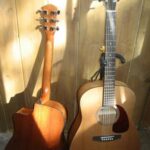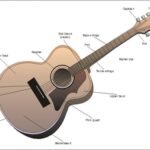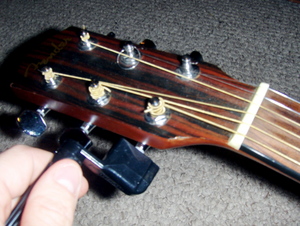I find that people think a lot about guitars, but not nearly as much about the strings they use in them. Every manufacturer has its own favorites and sells its new instruments already strung with them. Does this make them the best choice for everyone? Of course, not!
There are at least 8 common and readily available gauges (widths) of metal and wound strings made for acoustic guitars. These include, from the thinnest to the thickest, Extra Super Light, Super Light, Regular Light, Regular Light with Heavy Bass, Medium, Medium with Wound G String, Heavy and Extra Heavy. There are also a variety of methods of making them and a variety of different materials used, yielding literally hundreds of choices – not including the particular brand.
Each guitar manufacturer has tested it’s own instruments and, either as an honest assessment of what sounds best on it or, shamefully, as a result of a business deal with a particular string maker (some manufacturers make their own strings and, naturally, supply those with their guitars.) They sent the new guitar along to its first owned all set up with the strings they have selected.
The problem is that the strings that sound and feel best to their staff on a particular guitar may not be the best strings for you, as an individual player, to use. They may not feel the way you like strings to feel or produce the tones you want to hear when you strum or pick one of them. Finding the strings that are best for you can be as time-consuming and technically challenging activity as choosing the guitar itself.
As a man with 7 good guitars (both 6 and twelve strings) I have many personal examples.
One of my first fine guitars was a Martin HD28 (http://www.associatedcontent.com/article/248084/the_martin_hd28_confessions_of_a_martin.html.) It is a standard Dreadnought sized flat top guitar are is reputed to be the standard against which all other Dreadnaughts are judged. It came delivered with Medium Gauge Phosphor-Bronze wound strings. I began by believing that these were the best possible strings for this guitar as Martin had studied the issue and installed them. After all … Martin! They should know best, shouldn’t they? Well, not for me!
Well, I was mistaken. I have reasonably small fingers and discovered, after struggling with the Mediums for over a year, that I am able to get a perfectly lovely tone with a lot less finger effort out of Light gauge strings. Since making that discovery, I find myself playing this particular guitar at least twice as often as I used to,
On my favorite 12-string, a Taylor 355 (http://www.associatedcontent.com/article/248094/the_taylor_355_a_12string_guitar_symphony.html,) the guitar was delivered with Elixir Polyweb Lights – and they are perfect both for the sound I want and for their playability. A guild GAD 30R (http://www.associatedcontent.com/article/244919/quality_guitars_from_chinas_guild_gad.html) came with Guild Lights, but plays much better, from my point of view and to both my fingers and ears with Martin Phosphor Bronze Lights. I found the D’Addario Lights that came delivered on the Blueridge BR180 (http://www.associatedcontent.com/article/343326/the_blueridge_br180_musically_wonderful.html) to be entirely satisfactory! I discovered that models and factory decisions about strings notwithstanding, I am a Light gauge player!
I could give many other examples, but the important thing to remember is that the strings are a key element of what customizes your guitar to your own feel, strengths and desired tonal characteristics.
Luckily, a set of even very good guitar strings doesn’t cost a great deal and it is pretty simple to spend a few months trying out various types, gauges and brands of strings until you find the ones that do the best job for YOU.
What is best in the factory test room to the company technicians, is not necessarily what is best for you. If your guitar doesn’t feel or sound quite right to you, the simplest thing to try is changing the strings to something different. Give it a try. The variations may amaze you and I have personally found the loss of “punch” by going to a lighter gauge string to be quite minimal. If you don’t tell anyone, they will probably not hear any difference at all – and your fingers may thank you for it.




